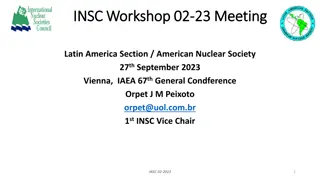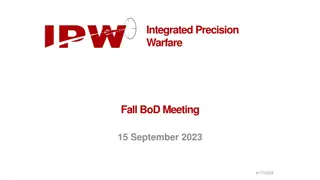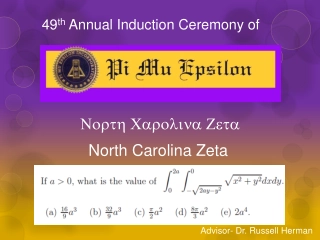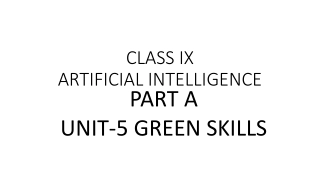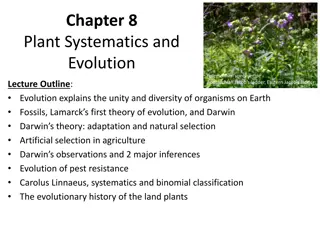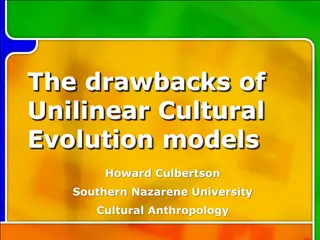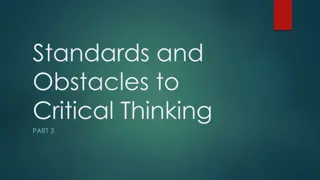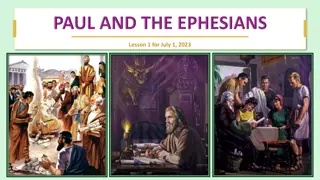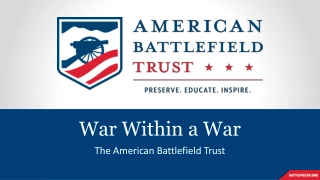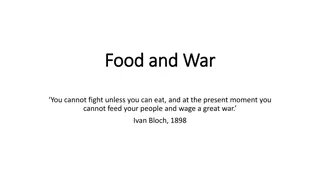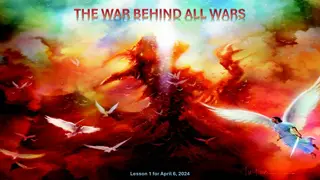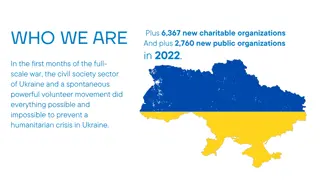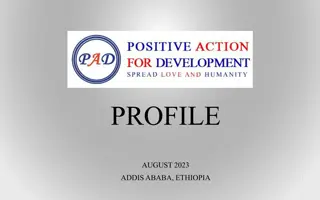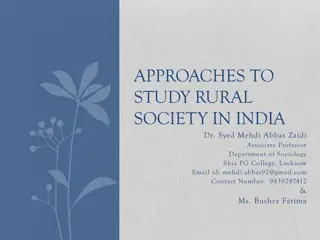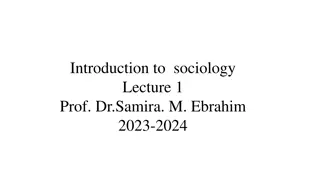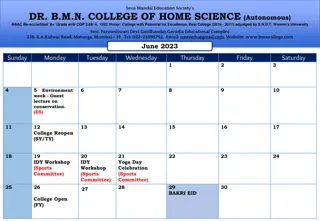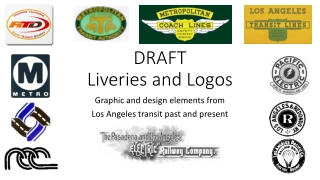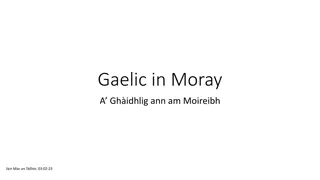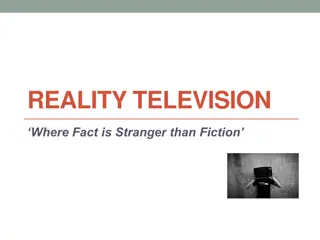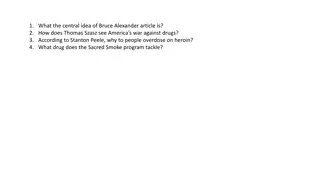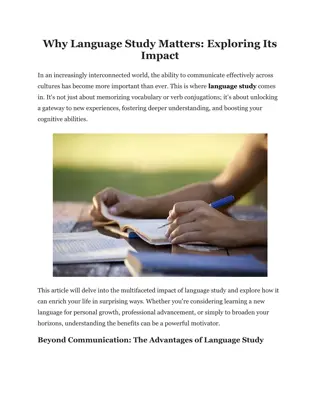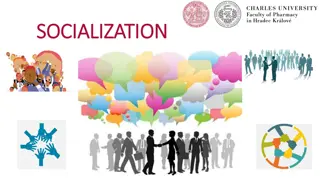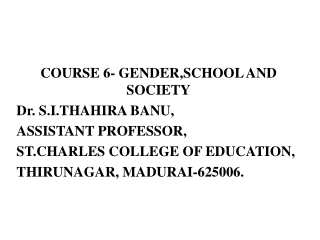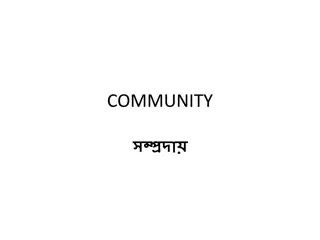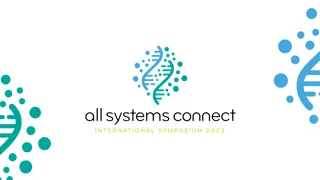Evolution of Warfare and Its Impact on Society
Warfare, defined as organized violence used to settle disputes, has influenced human life profoundly. Debates persist on whether warfare is declining or becoming more deadly as societies evolve. This chapter delves into the concept of war, its evolution, and expansion into various domains beyond geographical terrains, emphasizing its resilience in tandem with evolving societies.
Evolution of Warfare and Its Impact on Society
PowerPoint presentation about 'Evolution of Warfare and Its Impact on Society'. This presentation describes the topic on Warfare, defined as organized violence used to settle disputes, has influenced human life profoundly. Debates persist on whether warfare is declining or becoming more deadly as societies evolve. This chapter delves into the concept of war, its evolution, and expansion into various domains beyond geographical terrains, emphasizing its resilience in tandem with evolving societies.. Download this presentation absolutely free.
Presentation Transcript
CHAPTER 12: WAR CHAPTER 12: WAR Security studies cannot afford to ignore war: the reciprocal use of organized violence by adversaries trying to settle a dispute. War has influenced virtually every dimension of human life, including many of humanity s most enduring cultural reference points, shaped the deep meanings of masculinity and femininity, and set the contours of many laws, institutions, and customs. Debate continues over whether warfare is declining. Pinker (2011) argued the threat of humans suffering a violent death has receded significantly over the last few thousand years. Centeno and Enriquez (2016) contend that the history of warfare points in the opposite direction: it has become more deadly over time as societies developed and became more complex. This chapter analyzes the concept of war, its evolution, and its expansion into domains beyond geographical terrain. The central theme is war s resilience; it will continue to evolve in line with the societies that wage it. Security Studies: An Introduction. 4th Edition. Paul D. Williams and Matt McDonald. Routledge 2023. Paperback ISBN - 9781032162737 Information Classification: General
DEFINING WAR 1 DEFINING WAR 1 War can be defined as the art of adversaries using reciprocal organized violence to settle a dispute. It requires the formation of groups, the expression of hostile intent between them, the use of organized military force by one party to impose its will on the adversary, but also, crucially, the adversary s forceful response. Some analysts parse the master-concept into different types of warfare with distinct characteristics e.g., interstate war, conventional war, civil war, irregular war, guerrilla war, total war, nuclear war, limited war, hybrid war, X generation war, nonstate war, cyber war, space war, algorithmic war. In International Relations and security studies, the concept of warfare is often defined using cultural, legal, political, and sociological approaches. Security Studies: An Introduction. 4th Edition. Paul D. Williams and Matt McDonald. Routledge 2023. Paperback ISBN - 9781032162737 Information Classification: General
DEFINING WAR 2 DEFINING WAR 2 A cultural approach notes that warfare looks different and evokes different meanings depending where and when in human history analysts look. John Keegan (1994): war is always an expression of culture, often a determinant of cultural forms, in some societies the culture itself . A legal approach notes that war requires a declaration and the parties to acknowledge their joint participation in it. War is thus the legal condition which equally permits two or more hostile groups to carry on a conflict by armed force (Wright 1983). A political approach defines war as organised violence carried on by political units against each other. Violence is not war unless it is carried out in the name of a political unit [and] directed against another political unit (Bull 1977). A sociological approach sees war as a socially generative form of relations. Warfare consumes and reworks social and political orders and is a full spectrum social phenomenon inasmuch as it involves the complete range of social, cultural, economic and political relations, shaping everything from matters of state to gender relations, from high politics to popular culture (Barkawi 2011). Security Studies: An Introduction. 4th Edition. Paul D. Williams and Matt McDonald. Routledge 2023. Paperback ISBN - 9781032162737 Information Classification: General
DEFINING WAR 3 DEFINING WAR 3 A final approach to defining war is to clarify what it is not, by distinguishing it from related concepts. War is a form of organized violence but not all forms or organized violence should be understood as warfare. Examples might include criminal lynchings and mob violence, atrocities against non- combatants, and terrorism. War is also supposed to differ from organized crime. In war, the belligerents and their goals are understood as political in contrast to private, criminal associations primarily interested in accumulating wealth and profit rather than assuming sovereign or political authority to govern. Mass atrocities and genocidal violence are also distinct from, although often perpetrated during, war. This distinction has been formalised by the laws of armed conflict, which all regular militaries and combatants are meant to abide by. Security Studies: An Introduction. 4th Edition. Paul D. Williams and Matt McDonald. Routledge 2023. Paperback ISBN - 9781032162737 Information Classification: General
DEVELOPING THE WAR HABIT DEVELOPING THE WAR HABIT When humans invented warfare remains the subject of debate. Historical evidence of fortifications against organized attack found in Jericho suggests warfare dates back at least to 8,000 BC. For many years, war was waged by societies without regular armies, which didn t emerge until the first millennium BC. Mueller (2004) argues that, as a human invention, war is merely an idea that has been grafted onto human existence . But war is more than an idea; it is a habit that most human societies have acquired and become deeply attached to. War is thus often referred to as a social fact (Centeno and Enriqeuz 2016) or a deeply ingrained cultural practice (Coker 2014). Although there are examples of societies that have not engaged in (or even spoken of) warfare, the war habit became very widespread. This was largely because not engaging in war rendered a society vulnerable to those that did. Security Studies: An Introduction. 4th Edition. Paul D. Williams and Matt McDonald. Routledge 2023. Paperback ISBN - 9781032162737 Information Classification: General
WAR AND HUMAN BIOLOGY WAR AND HUMAN BIOLOGY War depends on human biological and psychological traits. Most contemporary scholars agree that our evolutionary biology suggests warfare is linked to the human ability to engage in deadly aggression and that, as a consequence, there are limits to how much humans can change. But our genes don t make warfare inevitable; humans are not biologically programmed for war. Gat (2006) put it well, aggression is both innate and optional. Deadly aggression is a major, evolution-shaped, innate potential that, given the right conditions, has always been easily triggered . It is human politics and psychology that triggers warfare; and means war can be limited in various ways. In IR, some of the most severe restrictions are referred to as taboos, some of which are enshrined in law. The most widely debated taboos are killing the defenceless (e.g., prisoners, the wounded, and unarmed civilians, or using indiscriminate anti-personnel landmines), as well as the use of nuclear and chemical weapons. Security Studies: An Introduction. 4th Edition. Paul D. Williams and Matt McDonald. Routledge 2023. Paperback ISBN - 9781032162737 Information Classification: General
WARS CHANGING CHARACTER WAR S CHANGING CHARACTER 1: RMAS 1: RMAS Some analysts have debated qualitative changes in the character of warfare with reference to Revolutions in Military Affairs (RMAs). RMAs can be defined as the emergence of technologies so disruptive that they overtake existing military concepts and capabilities and necessitate a rethinking of how, with what, and by whom war is waged (Brose 2019). Analysts have argued about well over a dozen historical RMAs; from the longbow and gunpowder, to airpower and nuclear weapons. The most recent RMA debate is whether advances in Artificial Intelligence and robotics constitute a genuine revolution (Singer 2009, Payne 2021). Security Studies: An Introduction. 4th Edition. Paul D. Williams and Matt McDonald. Routledge 2023. Paperback ISBN - 9781032162737 Information Classification: General
WARS CHANGING CHARACTER WAR S CHANGING CHARACTER2: NEW WARS WARS Some scholars have argued that especially since 1945, the processes of globalization have given rise to a distinctive form of organized violence, commonly labelled new wars . Kaldor (1999) argues that new wars blur the traditional distinctions between war (violence between states or organized political groups for political motives), organized crime (violence by private associations, usually for financial gain), and large-scale violations of human rights (violence by states or private groups against individuals, mainly civilians). These new wars are said to be distinct from old wars in terms of their goals, methods and systems of finance, all of which reflect the ongoing erosion of the state s monopoly of legitimate organized violence (Kaldor 1999). Scholars continue to argue over a number of common hypotheses about new wars . 2: NEW Security Studies: An Introduction. 4th Edition. Paul D. Williams and Matt McDonald. Routledge 2023. Paperback ISBN - 9781032162737 Information Classification: General
THE (NEW) DOMAINS OF WAR 1 THE (NEW) DOMAINS OF WAR 1 New or old, most wars have been fought in geographic domains: on land, on and under the sea, and more recently in the air. Constraints imposed by geography and climate meant that major wars have been confined to a relatively small portion of the Earth s surface. But warfare has expanded into new domains with potentially far- reaching consequences, especially due to the growing salience of urban spaces, cyberspace, and outer space. Humans have waged war in, on and around cities since at least 3,000 BCE. But today s state militaries have undergone several decades of significant personnel reductions. Hence, bigger cities combined with smaller forces have turned contemporary urban warfare into a series of localized micro-sieges in which combatants struggle over buildings, streets and districts (King 2021). Security Studies: An Introduction. 4th Edition. Paul D. Williams and Matt McDonald. Routledge 2023. Paperback ISBN - 9781032162737 Information Classification: General
THE (NEW) DOMAINS OF WAR 2 THE (NEW) DOMAINS OF WAR 2 Contemporary wars also involve more activities in cyberspace. This has generated extensive debate over the utility of the concept of cyberwar, how warfare shapes cyber operations, and the extent to which cyber operations influence warfare. Cyber operations have been used to damage digital systems and infrastructure, including by temporarily shutting down power grids, water, energy and healthcare services, air traffic control etc. However, so far, cyber operations don t seem to have significantly impacted the outcomes. In sum, to the extent that cyberwar exists, its lethality is questionable and its operational effects on the battlefield remain distinctly limited. Military doctrine of several great powers has framed outer space as a war-fighting domain and devoted more resources and focus to operating in outer space. Beyond doctrine, the weaponization of space is also increasing, although defining space weapons is complicated. Security Studies: An Introduction. 4th Edition. Paul D. Williams and Matt McDonald. Routledge 2023. Paperback ISBN - 9781032162737 Information Classification: General
ESSAY / EXAM QUESTIONS ESSAY / EXAM QUESTIONS What s the best way to define war and warfare? Is war natural and inevitable? Are any particular wars inevitable? How should analysts measure organized violence? Is warfare in decline? To what extent is Carl von Clausewitz s thinking about warfare still relevant today? To what extent has the character of armed conflict changed since the end of the Cold War? Have advances in Artificial Intelligence and robotics produced a Revolution in Military Affairs? Do you agree with Mary Kaldor s thesis that globalization has generated new wars ? Does cyberwar exist? How important is outer space for contemporary warfare? Security Studies: An Introduction. 4th Edition. Paul D. Williams and Matt McDonald. Routledge 2023. Paperback ISBN - 9781032162737 Information Classification: General
WEBSITES AND AUDIO WEBSITES AND AUDIO- -VISUAL RESOURCES VISUAL RESOURCES Databases on Armed Conflict Twelve acclaimed feature films addressing key themes in war Uppsala Conflict Data Programme: http://ucdp.uu.se Dr Strangelove or How I learned to stop worrying and love the bomb (1964):https://www.youtube.com/watch?v=98NaJ8ss4sY The Correlates of War Project: http://www.correlatesofwar.org The Battle of Algiers (1967): https://www.youtube.com/watch?v=HuIbM7_eOcg Armed Conflict Location and Event Data Project: http://www.acleddata.com All Quiet on the Western Front (1979): https://www.youtube.com/watch?v=DX1PW2n8POg Heidelberg Conflict Barometer: https://www.hiik.de/en/konfliktbarometer/ The Killing Fields (1984): https://www.youtube.com/watch?v=2ru0HxV4nWY Project Mars dataset on conventional wars fought between 1800 and 2011: https://dataverse.harvard.edu/dataset.xhtml?persistentId=doi:10.7910/DVN/DUO7IE Glory (1989):https://www.youtube.com/watch?v=0hVrYRqeT5M Sexual Violence in Armed Conflict: http://www.sexualviolencedata.org The Last Samurai (2003): https://www.youtube.com/watch?v=T50_qHEOahQ Some useful documentaries on key themes in war The Wind that Shakes the Barley (2006): https://www.youtube.com/watch?v=xhn5_gUcO5E The Vietnam War (2017):http://www.pbs.org/kenburns/the-vietnam-war/watch/ The Hurt Locker (2009): https://www.youtube.com/watch?v=JIgEhiUVKh8 Mogadishu Soldier (2017): http://www.imdb.com/title/tt6273226/ The Imitation Game (2014): https://www.youtube.com/watch?v=S5CjKEFb-sM Hubris: Iraq War Documentary (2013): https://www.youtube.com/watch?v=B5FaMbnINwc Hacksaw Ridge (2016):https://www.youtube.com/watch?v=s2-1hz1juBI Restrepo(2010): https://www.youtube.com/watch?v=-DjqR6OucBc Da 5 Bloods (2020): https://www.youtube.com/watch?v=D5RDTPfsLAI Fog of War: Eleven Lessons from the life of Robert S. McNamara (2003): https://vimeo.com/149799416 Dunkirk (2017): https://www.youtube.com/watch?v=F-eMt3SrfFU Security Studies: An Introduction. 4th Edition. Paul D. Williams and Matt McDonald. Routledge 2023. Paperback ISBN - 9781032162737 Information Classification: General


